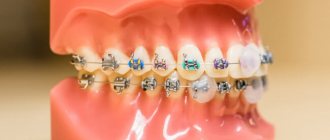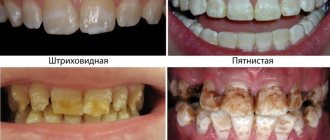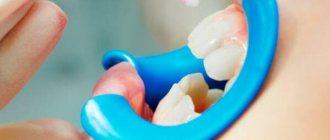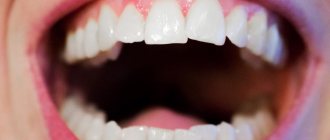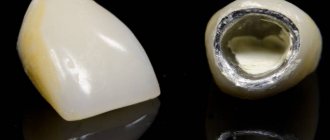Why do my child's teeth grow unevenly?
How straight your child’s teeth will be when he grows up depends on the developing bite and pathologies of individual teeth. The answer to the question “what bite is considered correct?” you hardly have any doubts - the one in which the upper jaw overlaps the lower jaw. However, normally, all children are born with progeny: their lower jaw is slightly pushed forward so that it is convenient to grasp the breast with their mouth when feeding. Over time, the lower jaw returns to its place, after which the process of bite formation begins - first the milk bite (up to 6 years), then the replacement (up to 11 years) and permanent (up to 15 years). How correct it will be depends on several factors:
- Heredity.
Uneven teeth in a child may be the result of heredity. If one of the parents has an incorrect bite or a wide gap between the front teeth, this can be passed on to the children at the genetic level.
- Congenital pathologies.
Insufficient amniotic fluid, viral infections and/or mechanical injuries during pregnancy and childbirth can all later cause abnormal jaw development and the appearance of uneven teeth in the child.
- Nutritional features.
If a child's diet does not contain enough natural solid foods (such as raw vegetables and fruits), his jaws do not receive the necessary chewing load. As a result, the risk of developing a malocclusion increases.
- Chronic diseases of the nasopharynx.
They make nasal breathing difficult, and the child is forced to breathe through the mouth. This negatively affects the formation of the bite.
- Bad habits.
For example, prolonged pacifier sucking, one-sided chewing, the habit of biting nails or holding foreign objects in the mouth can lead to bite problems in adulthood.
Rare teeth: causes, treatment methods, photos
There are several types of malocclusion. Rare teeth are the most common. It is characterized by the presence of very wide spaces between dental units. At the same time, the chewing structures are externally similar to a comb with sparse teeth.
This pathological condition cannot be ignored, as it can lead to the development of dangerous complications. Currently, there are several methods for treating rare teeth (a photo of the defect is presented below).
The feasibility of using a particular method is assessed by the orthodontist.
Causes and consequences
The “culprit” of the pathology is a genetic factor. Large distances between chewing units are noticeable already at the stage of eruption of milk teeth. In extremely rare cases, pathology develops against the background of progression of dental diseases.
Rare teeth in humans are not only unsightly, but also dangerous to health. Initially, psycho-emotional instability appears. It is caused by complexes that have arisen and low self-esteem.
In addition, sparse teeth cause the following pathological conditions:
- Disorders of the gastrointestinal tract. Wide spaces between dental units do not allow for proper chewing of food. As a result, food enters the stomach in an insufficiently processed form. The natural consequence is indigestion.
- Tooth loss. Chewing units located far from each other are characterized by increased fragility. In addition, they are extremely vulnerable to any external influences.
- Inflammatory processes in the oral cavity. When there are large gaps between teeth, soft tissues also become more vulnerable to external influences. They are easily injured, and when pathogenic microorganisms penetrate the oral cavity, an inflammatory process develops.
To prevent the development of complications and make your smile perfect, you need to contact an orthodontist. Only a doctor can provide information on how to correct rare teeth in each specific case.
Diagnostics
After the examination, the orthodontist will refer the patient for a comprehensive examination. Based on its results, the doctor will be able to make a decision on what to do with the rare teeth of the person who contacts him.
Diagnosis may include the following studies:
- Orthopantomogram. This is a three-dimensional shot of the jaws.
- X-ray examination.
- Computer diagnostics. The method is considered the most accurate and informative. It allows you to evaluate both the structure of the jaw and the location of the teeth.
Based on the diagnostic results, the orthodontist will select the most effective method of treating rare teeth.
It is important to understand that it is impossible to correct the genetic factor, but doctors are able to disguise the defect so that the patient’s smile is perfect.
Contrary to popular belief, if adults have sparse teeth, braces are powerless. This method of correcting the bite is not used if a person has large distances between the teeth.
Installation of a bridge
The use of fixed orthodontic structures is a modern way to fill wide gaps in the dentition.
In order for the prosthesis to be securely fixed, it is necessary to have supporting dental units. It is on them that the entire structure is attached.
The best option is to make a bridge from metal ceramics. The service life of this design is 7 years or more. At the same time, the bridge retains its original shade and does not differ from adjacent natural teeth.
Contraindications to installing a prosthesis on rare teeth:
- Acute periodontitis.
- Parafunctions of the masticatory muscles.
- Insufficient height of supporting teeth.
If there are absolute contraindications, the doctor makes a decision regarding the advisability of using a different treatment method.
Installation of veneers
This is a highly effective correction method. Veneers are thin plates made of ceramic or porcelain. They are placed on top of natural teeth.
The main advantage of the method is that the plates cover and protect the enamel coating of the dental units. In other words, there is no need to grind or file down adjacent teeth.
Contraindications for installing veneers:
- Severe destruction of dental units from the tongue.
- The presence of large fillings.
- Grinding of teeth.
- Having a bad habit of opening bottles with your teeth, cracking nuts with them, etc.
In addition, veneers cannot be installed if six or more chewing units are missing from the mouth.
Rare teeth in a child
Radical treatment methods are not used for children. In addition, a child under 5 years old just needs to be monitored.
This is due to the fact that after teething, the jaw continues to grow, so there must be gaps between the dental units. This is a normal physiological process.
It is necessary to consult a doctor only if the space between the teeth remains very wide after the eruption of all milk teeth.
Children may have braces. In most cases, after such an adjustment, the teeth will take the required position, and the distance between them will decrease.
If the cosmetic defect remains pronounced even after removing the braces, the doctor may recommend filling or installation of veneers.
The advantage of these methods is that there is no need to prepare natural teeth. It is recommended to give preference to the installation of veneers.
Thin plates can not only hide empty areas, but also protect the enamel from the harmful effects of external factors.
Finally
Rare teeth are a pathology caused by a genetic factor. This condition is characterized by the presence of large distances between dental units. This is not just a cosmetic defect. This phenomenon leads to disruption of the digestive system and serves as a trigger for the development of inflammatory processes in the oral cavity.
An orthodontist deals with the correction of cosmetic defects. Initially, the specialist prescribes a comprehensive examination to the patient, based on the results of which the doctor determines further treatment tactics. Currently, the most common methods for correcting rare teeth are implantation, filling, installation of bridges, crowns and veneers.
Source: https://FB.ru/article/420869/redkie-zubyi-prichinyi-metodyi-lecheniya-foto
Are uneven baby teeth a problem?
When a baby's first teeth begin to grow, they are usually straight and close together. As the child grows, his jaw also increases in size, causing the teeth to “diverge.” Normally, the spaces between the teeth should be even. If the first teeth are uneven and unequally spaced, this may indicate that the jaw is developing asymmetrically. Does your child have uneven baby teeth? Don't think that they will become smoother with age. Instead, take your child to the pediatric dentist. Timely diagnosis and treatment will help avoid serious consequences, such as the appearance of uneven molars.
Example 3
| Before orthodontic treatment | After orthodontic treatment |
Here, orthodontic treatment with braces has significantly improved the appearance of the teeth, but when everything is “not very good,” then little things do not attract attention. When the teeth were aligned, the uneven edges of the teeth became very noticeable (1), and the asymmetrical corner of the second incisor also stood out (2). Since this problem is easily solved, and the necessary specialist is in the same clinic, then why leave any imperfections? A comprehensive approach to dental aesthetics is necessary for the best results.
This is what happened as a result of the work of an aesthetic dentist after orthodontic treatment:
In this case, laser teeth whitening and restoration of the front teeth with light-curing material Estelite (Japan) were performed.
If your child's permanent teeth grow unevenly
Often, even a correct bite and straight baby teeth are not a guarantee that a child’s uneven molars will not “come out.” Most permanent teeth erupt unevenly (and this is normal), but as they “come out” they unfold. As the child's jaw grows, there is more room for new teeth, so they gradually take on the correct position. But it also happens that the jaw increases in size much more slowly than the teeth. As a result, the latter do not have enough free space, which is why they continue to grow unevenly or begin to “crawl” on top of each other, and sometimes even line up in two rows. A similar situation is also possible if a child has a baby tooth removed ahead of time.
What could be the consequences?
If you notice such a pathology in your baby, do not wait, but contact a specialist. Even temporary teeth need to be corrected because:
- the position of crooked primary teeth can correspondingly affect the growth of molar primordia;
- emerging problems with the hygiene of crooked teeth lead to the development of caries in hard-to-reach places, which subsequently penetrates the rudiments of the molars and affects them;
- improperly positioned primary teeth change the distribution of load on the jaw, which affects the functioning of the jaw joints and chewing muscles.
Read also: How long can you walk with arsenic in your tooth?
Devices for correcting uneven teeth
Braces
Most often they are installed on children over 12 years of age. These structures are non-removable and are made of different materials (metal, ceramics and others). They are securely attached to the teeth and, by exerting constant pressure on the teeth, over time they change the bite, correct crowding, and also eliminate large gaps between the teeth. Typically, treatment with braces takes from six months to two years (depending on the complexity of the clinical case).
Aligners
These are modern analogues of braces that can be used to straighten teeth from 16 to 18 years of age. They are translucent, almost invisible aligner trays on the teeth that must be worn around the clock, removing them only for eating and brushing teeth. Over 14 to 30 days, the teeth shift to a certain position, after which the aligners are replaced with the next pair. The treatment period is the same as in the case of braces.
Trainers, removable plates, lip bumpers
These devices are used to correct malocclusion and uneven teeth in children from 4 to 6 years of age. They should be worn for a certain number of hours or only worn at night. This treatment is very effective when the jaws are in the growth stage.
Attention!
Any orthodontic treatment requires consolidation of the result. To prevent straight teeth from assuming the wrong position again, for example, after straightening with braces, doctors recommend using retainers.
Disguise methods
Not every patient can use teeth straightening devices. There are anomalies that cannot be corrected. Or the patient may be contraindicated for such procedures. There may also be allergic reactions to the material of the leveling structure. In such cases, veneers come to the rescue. They are ceramic or composite parts that are attached to the treated tooth.
Veneers mask all imperfections: the presence of chips, developmental defects, large gaps between teeth, and can also correct the size of the dental organ.
We suggest you read: Nurofen helps with toothache
It takes a lot of time to install such a product. Their production itself takes approximately 2 weeks. You will also need to grind down the enamel, which means you will need more than one trip to the doctor.
The advantages of veneers include their low cost and the ability to choose their color relative to the color of the patient’s tooth enamel. The structure can last up to 10 years. It all depends on what material was used and how the installation was carried out.
In addition to veneers, similar designs are used - lumineers. Their application is the same, only lumineers do not require grinding down tooth enamel. They can be removed at any time; no restoration procedures are required. Lumineers are made only from ceramics. The thickness of the plate is from 0.2 millimeters. They are made within a month. Lumineers cost more than veneers.
Tips for parents on prevention
1. Wean your child off pacifiers in a timely manner (from about 8 to 9 months, since it is during this period that the baby develops a chewing reflex and the need for sucking decreases) or replace them with anatomically shaped vestibular plates.
2. Fight your child’s bad habits. Wean him off, for example, thumb sucking or nail biting.
3. Monitor your child’s diet, including more solid fresh vegetables and fruits in his diet - carrots, apples, pears, cucumbers and the like.
4. Monitor the health of teeth (including milk teeth) and gums by forcing your child to maintain oral hygiene. Visit the dentist with your child at least twice a year: treat caries and other dental diseases and try to prevent the loss of baby teeth too early - this can lead to displacement of the entire dentition. If premature removal of a baby tooth is unavoidable, doctors advise replacing it with a removable denture.
Treatment of the anomaly
Treatment of malocclusion is the responsibility of a qualified orthodontist. To effectively eliminate large gaps, the patient first undergoes a thorough diagnosis.
Based on individual examination results, the doctor determines the most effective treatment method.
Dental implantation
If there are large gaps in the dentition, the patient is prescribed dental implantation - the most radical way to restore the correct bite. During the procedure, rare teeth are replaced with special dentures that are embedded into the jawbone using a titanium root.
The advantage of this method is that the artificially manufactured implant is absolutely similar to a natural tooth and performs its functions. As a result, the load during chewing food is evenly distributed between artificial and natural units, which ensures the formation of a correct bite.
Application of bridges
If the cause of malocclusion is the lack of a large number of chewing units, the patient is fitted with a bridge. A metal-ceramic bridge is considered to be a suitable option: an artificial tooth made of ceramics qualitatively imitates the shade of the enamel coating of nearby units.
Bridges are a rather bulky structure because they are designed to replace two or more crowns. Despite this, this type of prosthetics restores the chewing function without impairing tactile sensitivity.
The disadvantage of this method is that before installing the bridge, adjacent healthy crowns are ground.
Sealing
The most common and affordable way to eliminate wide gaps is considered to be filling. Installing fillings on sparse teeth provides visual expansion of the chewing units.
To ensure that the filling has an aesthetic appearance and does not differ from natural bone tissue, doctors use high-quality material - ceramics or phosphorus - and also select the shade individually.
In addition to restoring the ideal shape of the crown, filling ensures the formation of a correct bite and normalizes chewing function.
"Contour image" method
The principle of this method is similar to the procedure for installing a filling. To eliminate wide gaps, a special material is applied to rare chewing units, with which the dentist gives the crown an ideal shape.
The advantage of the method is the absence of complex structures, the installation of which is time-consuming.
The use of “contouring” as a treatment for malocclusion is safe for human health, since the procedure does not involve the introduction of foreign bodies into the oral cavity.
Installation of crowns
If the unaesthetic appearance of the dentition is the result of the absence or severe destruction of an individual unit, the doctor uses the method of installing crowns. The artificial tooth is introduced into the root system using a metal pin.
Metal-ceramic crowns are considered to be a popular type of crown, due to its similarity to natural teeth and high strength. The average lifespan of an artificially created unit is 8 years, after which it is recommended to replace it with a new crown.
Veneers as a way to eliminate a defect
The installation of veneers is considered the most modern and effective method of correcting the dentition. A veneer is a thin plate made of porcelain or ceramic that replaces the outer enamel coating.
The use of small plates is carried out to restore the appearance of damaged teeth, as well as to protect natural units from external factors.
The advantage of the method is that the installation of veneers is carried out without violating the integrity of the enamel or causing damage to neighboring units.
